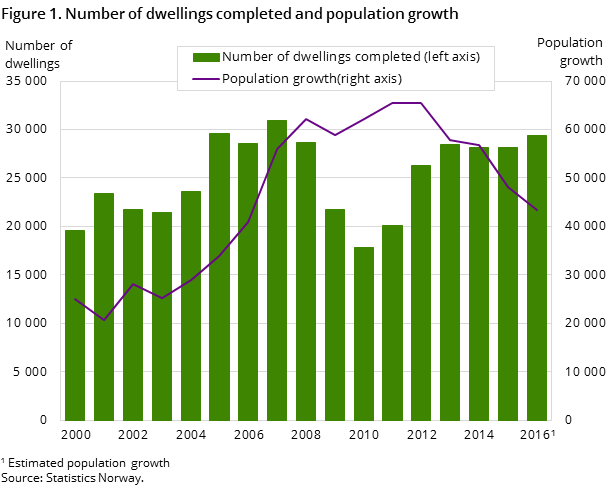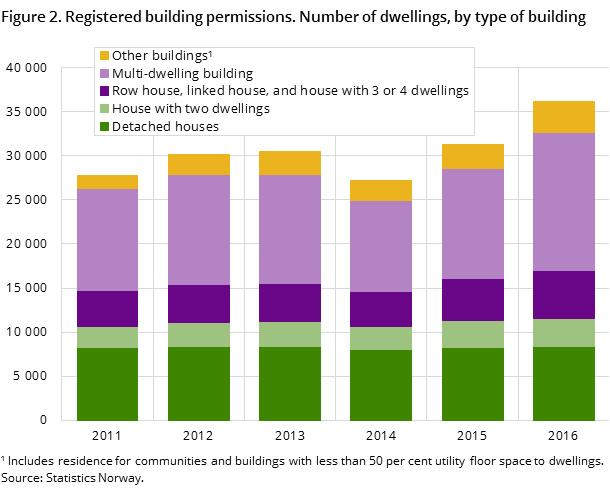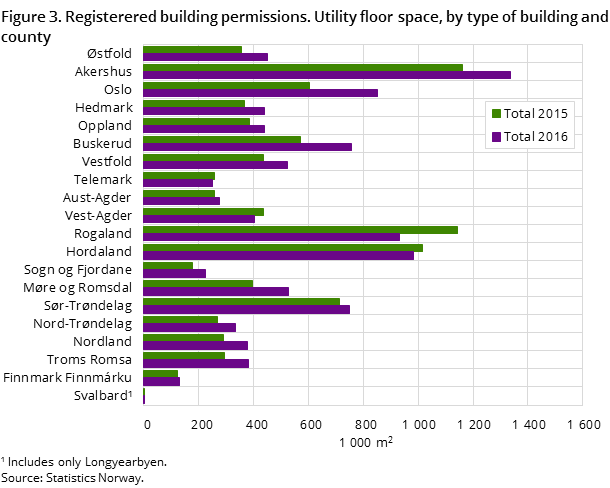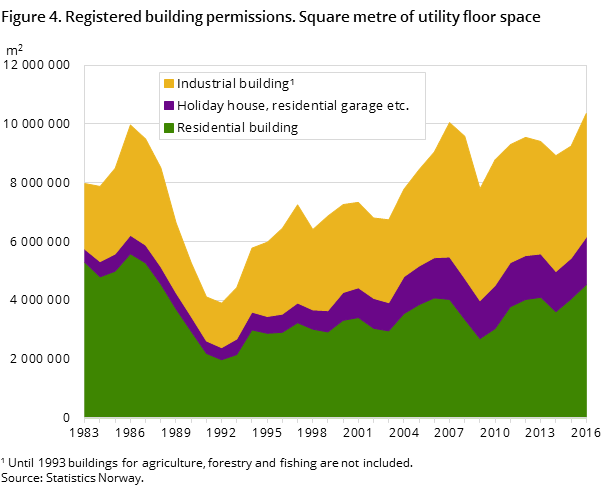Content
Published:
This is an archived release.
Record number of building permissions
In 2016, building start permits were given for 36 200 dwellings. This is 16 per cent more than in 2015. The number of registered building start permits has not been higher since 2000, when they were first measured.
| Dwellings | Utility floor space to dwellings | Utility floor space to other than dwellings | |
|---|---|---|---|
| Number | 1 000 m2 | 1 000 m2 | |
| 2016 | 36 203 | 4 545.8 | 5 815.7 |
| 2015 | 31 301 | 4 075.6 | 5 171.6 |
| 2014 | 27 250 | 3 641.3 | 5 281.9 |
| 2013 | 30 450 | 4 129.7 | 5 273.7 |
| 2012 | 30 189 | 4 039.5 | 5 504.6 |
| 2011 | 27 735 | 3 804.6 | 5 491.0 |
| 2010 | 21 145 | 3 059.1 | 5 726.8 |
| 2009 | 19 748 | 2 748.5 | 5 042.9 |
| 2008 | 25 950 | 3 379.5 | 6 205.2 |
| 2007 | 32 520 | 4 025.2 | 6 023.7 |
| 2006 | 33 314 | 4 080.6 | 4 969.4 |
| 2005 | 31 608 | 3 848.7 | 4 601.6 |
| 2004 | 29 999 | 3 543.4 | 4 239.3 |




The counties of Akershus and Oslo had the highest building activity. Akershus is the county with the highest building activity, with 5 500 new dwellings. Oslo county is, however, number one when it comes to flats, with 3 500, followed by Akershus with 2 900 new units.
Increase in non-residential buildings
In 2016, building start permits were given for 5.8 million square metres of utility floor space for “other than dwellings”. This is up 12 per cent from the year before. Of this, 1.6 million square metres is related to holiday houses, garages for residential buildings etc.
A total of 4.2 million square metres were given building start permits within the industrial sector, 10 per cent more than in 2015. Industrial and office buildings account for almost half of the activity.
Building more holiday homes
A total of 7 800 holiday houses were given building start permits in 2016. This is 14 per cent more than the year before. Buskerud is the county with the highest number of registered building start permits, with 1 193 holiday homes, followed by Oppland and Hedmark with 1 183 and 728 respectively.
2 423 new dwellings in old buildings
In addition to approximately 36 000 dwellings in new buildings in 2016, 2 423 dwellings were added due to rebuilding in existing buildings. Of these transformation dwellings, 944 were due to rebuilding of residential buildings, 1 330 were built in industrial buildings, and 149 were due to the rebuilding of garages, outhouses and annexes linked to dwellings, holiday homes etc.
2 585 demolished detached houses
In 2016, a total of 2 585 dwellings were demolished, of which 1 646 were detached houses. For buildings other than residential buildings, 13 903 buildings were demolished. Among these were buildings in the industrial sector, holiday homes and private garages.
Population growth and need for more dwellings
Figure 1 shows the number of completed dwellings and growth in population in the period 2000 to 2016. On average, there are approximately 2 persons per household. The distance between the curve for population growth and the columns for completed dwellings gives an illustration of the gap between the supply and demand for new dwellings.
Population growth has been high in recent years, especially in 2011 and 2012. In the years since, growth has moderated, and in 2016 population growth was the weakest since 2006. The population increased by 43 400 persons last year. The number of completed dwellings was at a relatively low level in the years after the financial crisis, and has hence increased. In 2016, the number of completed dwellings was at the same level as before the financial crisis. A total of 29 400 dwellings were completed last year. When building activity cannot keep pace with the growth in population, additional pressure is added to the dwelling market. In 2015 and 2016, however, more dwellings have been completed than the net increase in households, for the country as a whole.
Registered building permissionsOpen and readClose
Figures for buildings in the building statistics rely on dates for when permits are registered by the municipality in the data register (Matrikkelen). A building permit does not always mean that construction will be started at once. Especially in low conjunctures it might be that construction projects are not realised, or may be postponed after a building permit has been granted. When the building activity trend turns from a low to a high level, and vice versa, this could affect the interpretation of the statistics.
More details about comparability, quality and other information are available in About the statistics .
Rebuilding of existing building stockOpen and readClose
Building statistics do not cover dwellings due to rebuilding of existing building stock (i.e. new dwellings due to reconstruction of utility floor space from industry to dwellings).
When an old building is being demolished to the foundation wall, it is regarded as a new building. When the building framework is not demolished, it counts as rebuilding.
For more information, see About the statistics .
Contact
-
Jens Mathiesen
E-mail: jens.mathiesen@ssb.no
tel.: (+47) 40 81 13 98
-
Magnus Espeland
E-mail: magnus.espeland@ssb.no
tel.: (+47) 45 27 40 08
